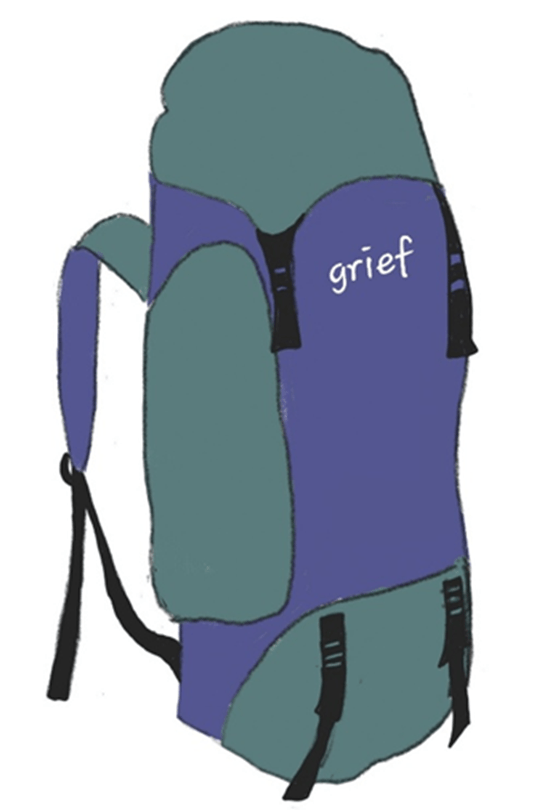Content warning: suicide, suicide bereavement, stigma around suicide, grief
All staff in our Suicide Bereavement Services have lived experience of someone in their lives dying by suicide. This allows them to deliver the compassionate and practical support that we are known for.
We hope that by sharing stories, we can make those who have been bereaved by or affected by someone taking their own life feel less alone. We also aim to educate those who have not been impacted around how losing someone to suicide differs from other experiences of loss. Overall, we hope this will continue to break down the stigma that still exists around deaths by suicide.
Here, Christian Smith, one of our Postvention Practitioners, shares the metaphors and analogies that are helpful for him when thinking about grief and loss.
Hi everyone! My name is Christian. I hope you are doing OK and seeking support when you need it.
Throughout my time working for the Leeds Suicide Bereavement Service (LSBS), it has occurred to me just how often we bereaved find ourselves using metaphors and analogies to describe our experiences with grief and loss.
Traumatic loss can overwhelm the senses, our learned ways of coping, and our ability to express new depths of meaning and emotion through language. For me, using metaphors allows us to view grief at a distance and to attempt to explain and make sense of our feelings, thoughts, and behaviours.

Christian’s sketch of ‘the grief backpack’
The Invisible Grief Backpack
One of the ways that I have described my grief is using the metaphor of an Invisible Grief Backpack. I have walked around with an emotional weight on my shoulders since my loss. I didn’t volunteer to carry this heavy load and I didn’t expect to have to. Before The Backpack, I had the capacity to tackle new situations, I could respond and adapt quicker to new stressors in my life. Now, I have to consider The Backpack at all times.
Sometimes it feels lighter, more organised, but then the weight is back and I’m struggling to keep everything inside. It spills out, often when I am not ready to face it, and I need time to reorganise. At first this was embarrassing, exposing, and isolating at the same time.
I asked myself:
- Should I be struggling so much to carry this weight, and ashamed of my reaction to its contents?
- Is it ok to struggle publicly? What do people think of me? Is this normal?
- Other people can’t see what I’m carrying, it’s invisible – should I act as if it’s not there too?
Sometimes The Backpack seems socially unacceptable…
People ask: “Why are you always / still wearing that old thing? Isn’t it time you got rid of that?”
Peer Support Invisible Grief Backpacks
I see our sessions at LSBS as much needed time and space to put down our backpacks. To put them in front of us, together, and to take a tentative look at the contents. As peers, we create a respectful and non-judgemental atmosphere, where we can feel safe to examine what we have been carrying. People who haven’t had a bereavement by suicide might not understand the full extent of what we are hauling around. I believe that peer support allows the invisible weight of our Grief Backpacks to be seen and understood and allows us to begin to make sense of our experience in our own ways, and our own time.
I know I avoided acknowledging my backpack for a couple of years. I felt its presence, but I worried about the mess it would make if I opened it. What if I struggled to contain or was unable to bear what was inside?
Referring in to LSBS as a client gave me a space to do some safe and tentative rummaging in my Grief Backpack, in the presence of someone who had been there, done that and got The Backpack themselves.
I knew that when I left sessions with LSBS, or a heart-to-heart with a close friend, I had to put The Backpack back on… but having that time and space to do some sorting and repacking, made everything feel that tiny bit lighter and manageable.
Ways I’ve made my grief backpack more manageable over time:
- Can I identify anything practical in my backpack that I can work towards completing, and ultimately remove?
- Is there an uncomfortable emotion stuck at the bottom – getting bigger, adding more weight? Do I feel able to look at that now or is that for later?
- Am I carrying other people’s emotions / perceptions? What is mine?
- What is my relationship to my backpack at the moment? Is it freely accessible or is it avoided and unacknowledged?
- Are the contents stuffed in or organised?
- If/when I notice a slight in a shift in weight, what is that? Has something helped or have things become harder? Why is that?
Your turn
This is one of the many ways that I’ve attempted to explain my own experience of loss (to myself and others). Metaphors and stories can help us to find language to express our thoughts and feelings.
I’d like to invite you to share metaphors/analogies/stories/fables/and beyond that have helped you to make meaning around your grief. Please also feel free to give feedback on The Invisible Backpack metaphor. Does it feel consistent with your experiences? How would you tweak it? What is your version?
If you’d like to, please send your thoughts to Christian.smith@leedsmind.org.uk.
[As always, please refrain from using graphic imagery and from discussion of methods of suicide]
Huge thank you to Christian for sharing his ideas. If you have been affected by suicide, please consider accessing our Suicide Bereavement Services. You can find more information on them here: https://www.leedsmind.org.uk/suicide-bereavement-services-west-yorkshire/
We also have a grief and loss support line, which you can call for free on 0800 196 3833 (8am – 8pm, 7 days a week). For more info, please visit: https://www.griefandlosswyh.co.uk



